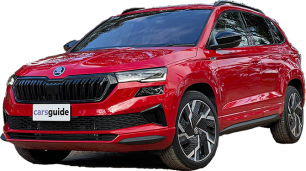The updated Karoq comes with more standard gear compared with the model it replaces, and a price increase.
As with the pre-facelifted model, the Karoq is available in just two model grades. The range kicks off with the front-wheel drive 110TSI Style priced at $42,990 drive-away, while the flagship remains the all-wheel drive 140TSI Sportline 4x4 at $49,990. Both variants are $3000 more expensive than before.
Skoda Australia says the updated Karoq 110TSI Style includes about $4500 worth of extra gear over its predecessor, which represents $1500 of better value when taking into account the price increase.
Some of the new standard kit includes 18-inch alloy wheels (up from 17s), LED headlights, front parking sensors (it already had rear sensors), a hands-free power tailgate, power-folding and heated exterior mirrors, a rear spoiler, extended pedestrian protection for the autonomous emergency braking system, driving profile selection, digital radio, wireless phone charging and luggage nets.
Other standard gear includes rain-sensing wipers, keyless entry and start, dual-zone climate control, ‘virtual cockpit’ digital instrument cluster, 8.0-inch multimedia screen with wired and wireless Apple CarPlay and Android Auto.
You can option the Style grade with a panoramic sunroof ($1900), side steps ($1200), a 'Tech Pack' ($5900) that adds a larger 9.2-inch central screen with gesture control, Matrix LED headlights, auto parking, lane assist, traffic jam assist and more, or a 'Premium Pack' ($10,900) that includes leather-appointed seats, power front seats, front and rear heated seats, a heated steering wheel, and more.
Stepping up to the Sportline 4x4 will net you sports seats throughout, larger 19-inch alloy wheels, Matrix LED headlights, fog lights, a black body kit, stainless steel pedal covers, a sports steering wheel and of course, a beefier turbocharged engine.
The additions to the Sportline amount to $4100, making for $1100 of extra value, according to Skoda’s calculations.
The Sportline can also be optioned with packs including a 'Leather Seats Pack' ($3200) and 'Premium Pack' ($5900).
Skoda’s pricing puts the 110TSI Style in the crosshairs of other medium SUVs like the Mazda CX-5 Maxx Sport ($40,690, before on-road costs) or the Kia Sportage 2.0 SX+ ($41,500, BOC).
The Sportline lines up against the Toyota RAV4 Edge petrol AWD ($50,200, BOC) and the mechanically related Volkswagen Tiguan 132TSI Life AWD ($46,690, BOC).
The Skoda’s standard features list could be described as generous without being over the top. While it outpaces a few rivals for tech and in-car features, it lacks some of the safety gear standard on those models. More on that in a bit.






.png)
















































.png)
























 copy.png)
















